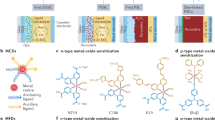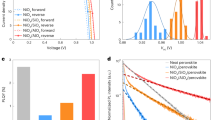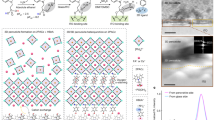Abstract
Optoelectronic devices consist of heterointerfaces formed between dissimilar semiconducting materials. The relative energy-level alignment between contacting semiconductors determinately affects the heterointerface charge injection and extraction dynamics. For perovskite solar cells (PSCs), the heterointerface between the top perovskite surface and a charge-transporting material is often treated for defect passivation1,2,3,4 to improve the PSC stability and performance. However, such surface treatments can also affect the heterointerface energetics1. Here we show that surface treatments may induce a negative work function shift (that is, more n-type), which activates halide migration to aggravate PSC instability. Therefore, despite the beneficial effects of surface passivation, this detrimental side effect limits the maximum stability improvement attainable for PSCs treated in this way. This trade-off between the beneficial and detrimental effects should guide further work on improving PSC stability via surface treatments.
This is a preview of subscription content, access via your institution
Access options
Access Nature and 54 other Nature Portfolio journals
Get Nature+, our best-value online-access subscription
$29.99 / 30 days
cancel any time
Subscribe to this journal
Receive 51 print issues and online access
$199.00 per year
only $3.90 per issue
Buy this article
- Purchase on Springer Link
- Instant access to full article PDF
Prices may be subject to local taxes which are calculated during checkout




Similar content being viewed by others
Data availability
The data that support the findings of this study are available from the corresponding authors on reasonable request.
References
Lee, J.-W., Tan, S., Seok, S. I., Yang, Y. & Park, N.-G. Rethinking the A cation in halide perovskites. Science 375, eabj1186 (2022).
Jung, E. H. et al. Efficient, stable and scalable perovskite solar cells using poly(3-hexylthiophene). Nature 567, 511–515 (2019).
Jiang, Q. et al. Surface passivation of perovskite film for efficient solar cells. Nat. Photon. 13, 460–466 (2019).
Yoo, J. J. et al. An interface stabilized perovskite solar cell with high stabilized efficiency and low voltage loss. Energy Environ. Sci. 12, 2192–2199 (2019).
Ni, Z. et al. Resolving spatial and energetic distributions of trap states in metal halide perovskite solar cells. Science 367, 1352–1358 (2020).
Yang, Y. et al. Top and bottom surfaces limit carrier lifetime in lead iodide perovskite films. Nat. Energy 2, 16207 (2017).
Smith, M. B. & March, J. March’s Advanced Organic Chemistry: Reactions, Mechanisms, and Structure 6th edn (Wiley, 2006).
Bergmann, V. W. et al. Local time-dependent charging in a perovskite solar cell. ACS Appl. Mater. Interfaces 8, 19402–19409 (2016).
Cai, M. et al. Control of electrical potential distribution for high-performance perovskite solar cells. Joule 2, 296–306 (2018).
Söderström, T., Haug, F.-J., Terrazzoni-Daudrix, V. & Ballif, C. Optimization of amorphous silicon thin film solar cells for flexible photovoltaics. J. Appl. Phys. 103, 114509 (2008).
Tsai, H. et al. Design principles for electronic charge transport in solution-processed vertically stacked 2D perovskite quantum wells. Nat. Commun. 9, 2130 (2018).
Tan, S. et al. Steric impediment of ion migration contributes to improved operational stability of perovskite solar cells. Adv. Mater. 32, 1906995 (2020).
Azpiroz, J. M., Mosconi, E., Bisquert, J. & De Angelis, F. Defect migration in methylammonium lead iodide and its role in perovskite solar cell operation. Energy Environ. Sci. 8, 2118–2127 (2015).
Domanski, K. et al. Migration of cations induces reversible performance losses over day/night cycling in perovskite solar cells. Energy Environ. Sci. 10, 604–613 (2017).
Bai, S. et al. Planar perovskite solar cells with long-term stability using ionic liquid additives. Nature 571, 245–250 (2019).
Wang, Z. et al. Efficient ambient-air-stable solar cells with 2D–3D heterostructured butylammonium-caesium-formamidinium lead halide perovskites. Nat. Energy 2, 17135 (2017).
Kim, M. et al. Methylammonium chloride induces intermediate phase stabilization for efficient perovskite solar cells. Joule 3, 2179–2192 (2019).
Min, H. et al. Efficient, stable solar cells by using inherent bandgap of α-phase formamidinium lead iodide. Science 366, 749–753 (2019).
Yoo, J. J. et al. Efficient perovskite solar cells via improved carrier management. Nature 590, 587–593 (2021).
Tan, S. et al. Shallow iodine defects accelerate the degradation of α-phase formamidinium perovskite. Joule 4, 2426–2442 (2020).
Zhao, J. et al. Strained hybrid perovskite thin films and their impact on the intrinsic stability of perovskite solar cells. Sci. Adv. 3, eaao5616 (2017).
Lin, Y. et al. Excess charge-carrier induced instability of hybrid perovskites. Nat. Commun. 9, 4981 (2018).
Carrillo, J. et al. Ionic reactivity at contacts and aging of methylammonium lead triiodide perovskite solar cells. Adv. Energy Mater. 6, 1502246 (2016).
Besleaga, C. et al. Iodine migration and degradation of perovskite solar cells enhanced by metallic electrodes. J. Phys. Chem. Lett. 7, 5168–5175 (2016).
Ahn, N. et al. Trapped charge-driven degradation of perovskite solar cells. Nat. Commun. 7, 13422 (2016).
Heimel, G., Rissner, F. & Zojer, E. Modeling the electronic properties of π-conjugated self-assembled monolayers. Adv. Mater. 22, 2494–2513 (2010).
Brown, P. R. et al. Energy level modification in lead sulfide quantum dot thin films through ligand exchange. ACS Nano 8, 5863–5872 (2014).
Zerweck, U., Loppacher, C., Otto, T., Grafström, S. & Eng, L. M. Accuracy and resolution limits of Kelvin probe force microscopy. Phys. Rev. B 71, 125424 (2005).
Kresse, G. & Furthmuller, J. Efficiency of ab-initio total energy calculations for metals and semiconductors using a plane-wave basis set. Comput. Mater. Sci. 6, 15–50 (1996).
Perdew, J. P. et al. Restoring the density-gradient expansion for exchange in solids and surfaces. Phys. Rev. Lett. 100, 1–4 (2008).
Grimme, S., Antony, J., Ehrlich, S. & Krieg, H. A consistent and accurate ab initio parametrization of density functional dispersion correction (DFT-D) for the 94 elements H–Pu. J. Chem. Phys. 132, 154104 (2010).
Blöchl, P. E. Projector augmented-wave method. Phys. Rev. B 50, 17953–17979 (1994).
Grimme, S., Bannwarth, C. & Shushkov, P. A robust and accurate tight-binding quantum chemical method for structures, vibrational frequencies, and noncovalent interactions of large molecular systems parametrized for all spd-block elements (Z = 1–86). J. Chem. Theory Comput. 13, 1989–2009 (2017).
Bannwarth, C., Ehlert, S. & Grimme, S. GFN2-xTB—an accurate and broadly parametrized self-consistent tight-binding quantum chemical method with multipole electrostatics and density-dependent dispersion contributions. J. Chem. Theory Comput. 15, 1652–1671 (2019).
Grimme, S. et al. Fully automated quantum-chemistry-based computation of spin-spin-coupled nuclear magnetic resonance spectra. Angew. Chem. Int. Edn 56, 14763–14769 (2017).
Grimme, S., Ehrlich, S. & Goerigk, L. Effect of the damping function in dispersion corrected density functional theory. J. Comput. Chem. 32, 1456–1465 (2011).
Hirshfeld, F. L. Bonded-atom fragments for describing molecular charge densities. Theor. Chim. Acta 44, 129–138 (1977).
Acknowledgements
This work was supported by the US Department of Energy’s Office of Energy Efficiency and Renewable Energy (EERE) under the Solar Energy Technologies Office under award number DE-EE0008751. J.-W.L. acknowledges support from a Korea Institute of Energy Technology Evaluation and Planning (KETEP) grant funded by the Korea government (MOTIE) (grant numbers 20214000000640, 20213030010400) and a POSCO Science Fellowship from the POSCO TJ Park Foundation. The TEM work at UC Irvine was supported by the National Science Foundation (NSF) under grant number DMR-2034738. Part of the computing resources used in this work were provided by the National Center for High-Performance Computing of Turkey (UHEM). Y.J.S. and J.-W.L. acknowledge support by the National Research Foundation of Korea (NRF) grant funded by the Korea government (MSIT) (grant numbers NRF-2022R1C1C1011975 and NRF-2021R1A2C2007141). N.-G.P. acknowledges financial support from NRF grants funded by MSIT under contract NRF-2021R1A3B1076723 (Research Leader Program). We acknowledge the use of facilities and instrumentation at the UC Irvine Materials Research Institute (IMRI), which is supported in part by the National Science Foundation through the UC Irvine Materials Research Science and Engineering Center (DMR-2011967). Work at the Molecular Foundry was supported by the Office of Science, Office of Basic Energy Sciences, of the US Department of Energy under contract number DE-AC02-05CH11231. We thank M. E. Liao, K. Huynh, M. S. Goorsky, S. Nuryyeva, K. N. Houk, K.-H. Wei and B. Jeong for experimental assistance, measurements or discussions; and S. Shelton, Y. Liu and the Molecular Foundry for the third-party laboratory device efficiency measurements.
Author information
Authors and Affiliations
Contributions
S.T., T.H. and Y.Y. conceived the idea. S.T. and T.H. designed and conducted most of the experiments, supervised by Y.Y. T.W.Y., K.P., D.-K.L. and T.Y. performed the KPFM and AFM measurements and analysed the data, supervised by Y.J.S., J.-W.L. and N.-G.P. I.Y. did the theoretical calculations, modelling and data analysis. M.X. performed the STEM and EDX measurements and analysis, supervised by X.P. Q.X. performed the confocal PL mapping and part of the UPS measurements. C.-H.C., R.Z. and D.M. performed the chemical synthesis. Q.X. and K.P. assisted with experiments and film and device fabrication. R.W., Y.Z., H.-C.W., J.X. and J.-W.L. assisted with data analysis and discussion. S.T., T.H., R.W., J.-W.L. and Y.Y. wrote the manuscript, and all authors contributed feedback and commented on the manuscript.
Corresponding authors
Ethics declarations
Competing interests
The authors declare no competing interests.
Peer review
Peer review information
Nature thanks the anonymous reviewer(s) for their contribution to the peer review of this work.
Additional information
Publisher’s note Springer Nature remains neutral with regard to jurisdictional claims in published maps and institutional affiliations.
Extended data figures and tables
Extended Data Fig. 1 Morphology of the perovskite films.
Surface morphology of the: a, reference; b, OAI-treated; c, OATsO-treated; d, OATFA-treated; e, OABr-treated; and f, OABF4-treated perovskite films measured by SEM. All scale bars represent 2 μm. No obvious difference can be seen between the reference and treated perovskite films.
Extended Data Fig. 2 Topography of the passivated perovskite films.
Representative 3D topography of the: a, OAI-treated; b, OABF4-treated; and c, OATsO-treated perovskite films measured by AFM. All scale bars represent 2 μm. d, Comparison of the height depth distribution of the films. Depth distribution histograms for the: e, OAI-treated; f, OABF4-treated; and g OATsO-treated perovskite films. Insets include the fitted statistical parameters. SD, standard deviation.
Extended Data Fig. 3 Heterointerface energy band diagrams.
Schematic interpretation of the heterointerface band alignments of the a, OAI-treated and b, OATsO-treated devices under illumination in open-circuit condition. The band alignments are constructed based on the UPS and KPFM results. CBM, conduction band minimum; VBM, valence band maximum; \({E}_{{fn}}\), electron quasi-fermi level; \({E}_{{fp}}\), hole quasi-fermi level. The dashed gray lines in b indicate \({E}_{{fn}}\) and \({E}_{{fp}}\)of the OAI-treated device from a. The diagrams are not drawn to scale. Both surface treatments create a type I energy alignment at the heterointerface, but the vacuum level upshift of the OATsO-treated device minimized the potential well to mitigate the electron accumulation.
Extended Data Fig. 4 Device cross-sectional KPFM profiling.
a, CPD profile; b, KPFM spatial mapping; c, corresponding AFM spatial mapping; and d, electric field distribution of the OAI-treated device. e, CPD profile; f, KPFM spatial mapping; g, corresponding AFM spatial mapping; and h, electric field distribution of the OATsO-treated device. Measurements were performed under illumination in open-circuit condition. All scale bars represent 300 nm. The CPD offsets were adjusted such that the CPD value of the buffer layer becomes zero. Note that this does not affect the electric field and charge displacement profiles, which calculate the derivatives of the CPD profiles. Although we do not expect the rough morphology seen in c to affect the KPFM signal, we cannot completely rule this out at this stage. Therefore, we have repeated the KPFM measurement on another separate OAI-treated device. As shown in Supplementary Fig. 4, we were able to reproduce the potential drop at the perovskite/spiro-MeOTAD heterointerface.
Extended Data Fig. 5 Device photovoltaic parameters.
Box plots showing the distribution of the: a, VOC; b, JSC; c, FF; and d, PCE of the devices. Centre line, median; box limits, 25th and 75th percentiles; whiskers, outliers.
Extended Data Fig. 6 Characterization of the OATsO-treated devices.
a, Current density-voltage curves of the best-performing OATsO-treated device, in reverse scan (blue line) and forward scan (red line). Inset includes the measured photovoltaic parameters. b, EQE spectrum and integrated JSC of an OATsO-treated device. The integrated JSC is 24.6 mA cm−2, and therefore well matched (less than 3% discrepancy) with the measured value. c, Absorbance profile of an OATsO-treated film on glass measured by UV-Vis spectroscopy. Inset includes a Tauc plot and linear fits to estimate the optical bandgap.
Extended Data Fig. 7 Third-party device performance measurements.
a, Current density-voltage curve, and b, box plot showing the PCE distribution of the encapsulated OATsO-treated devices. Measurements were performed at the Molecular Foundry, Berkeley, CA, USA. As the measurements were fully done in ambient air (RH approximately 50%), all devices had to be encapsulated, which resulted in a drop in performance. c, PCE evolution with time under lightsoaking of an encapsulated OATsO-treated device. Current density-voltage curves of the same device d, before and e, after the encapsulation procedure, measured in-house.
Extended Data Fig. 8 Universality verification on a FAPbI3 composition.
a, UPS secondary electron cut-offs of the perovskite films. b, Steady-state and c, time-resolved PL spectra of the glass/perovskite films. d, Steady-state and e, time-resolved PL spectra of the glass/perovskite/spiro-MeOTAD films. The carrier lifetimes are fitted with a mono-exponential decay function. f, Box plots of the distribution of the device photovoltaic parameters. Centre line, median; box limits, 25th and 75th percentiles; whiskers, outliers. g, Current density-voltage curves and h, EQE spectrum and integrated JSC of the best-performing device treated with OATsO. The integrated JSC is 25.4 mA cm−2, well matched (approximately 3% discrepancy) with the measured scan value.
Extended Data Fig. 9 Open-circuit stability test device performance.
Evolution with time of the normalized average a, Jsc, b, VOC, and c, FF of the devices under continuous illumination with a metal halogen lamp. The encapsulated devices were aged in ambient atmosphere at RH ~ 40% and T ~ 40 °C in open‐circuit condition. Error bars represent the standard deviation of four devices for each condition.
Extended Data Fig. 10 Activation energy for halide migration.
a–c, Energy profiles for the extra-lattice migration of a, bromine and b, iodine in a neutral uncharged or negatively charged environment, and c, corresponding activation energy barriers. d–f, Energy profiles for the intra-lattice migration of d, bromine and e, iodine in a neutral uncharged or negatively charged environment, and f, corresponding activation energy barriers.
Supplementary information
Supplementary Information
This file contains Supplementary Notes 1–10, Tables 1–7, Figs. 1–20 and References.
Rights and permissions
About this article
Cite this article
Tan, S., Huang, T., Yavuz, I. et al. Stability-limiting heterointerfaces of perovskite photovoltaics. Nature 605, 268–273 (2022). https://doi.org/10.1038/s41586-022-04604-5
Received:
Accepted:
Published:
Issue Date:
DOI: https://doi.org/10.1038/s41586-022-04604-5
This article is cited by
-
Efficient tin-based perovskite solar cells with trans-isomeric fulleropyrrolidine additives
Nature Photonics (2024)
-
Double-side 2D/3D heterojunctions for inverted perovskite solar cells
Nature (2024)
-
Inhibition of halide oxidation and deprotonation of organic cations with dimethylammonium formate for air-processed p–i–n perovskite solar cells
Nature Energy (2024)
-
Multifunctional sulfonium-based treatment for perovskite solar cells with less than 1% efficiency loss over 4,500-h operational stability tests
Nature Energy (2024)
-
Frequency-selective perovskite photodetector for anti-interference optical communications
Nature Communications (2024)
Comments
By submitting a comment you agree to abide by our Terms and Community Guidelines. If you find something abusive or that does not comply with our terms or guidelines please flag it as inappropriate.



